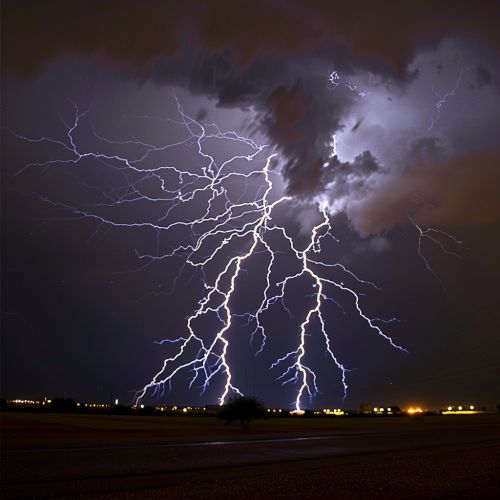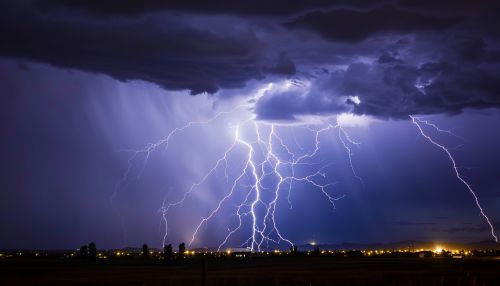Meteorological Phenomena
Meteorological Phenomena
Meteorological phenomena encompass a wide range of atmospheric events and processes that influence the Earth's weather and climate. These phenomena are driven by complex interactions between the atmosphere, hydrosphere, lithosphere, and biosphere. This article delves into the various types of meteorological phenomena, their underlying mechanisms, and their impacts on the environment and human activities.


Atmospheric Dynamics
Atmospheric dynamics refer to the study of motion in the Earth's atmosphere, driven by forces such as pressure gradients, Coriolis effect, and friction. The fundamental principles governing atmospheric dynamics include the Navier-Stokes equations, which describe the motion of fluid substances. These equations are essential for understanding large-scale phenomena such as jet streams, cyclones, and anticyclones.
Jet Streams
Jet streams are fast-flowing, narrow air currents found in the upper levels of the atmosphere. They are primarily located near the tropopause, the boundary between the troposphere and the stratosphere. Jet streams are formed due to the temperature gradients between polar and tropical air masses. These currents play a crucial role in influencing weather patterns and the development of storm systems.
Cyclones and Anticyclones
Cyclones are large-scale air masses that rotate around a strong center of low atmospheric pressure. They are characterized by inward spiraling winds that rotate counterclockwise in the Northern Hemisphere and clockwise in the Southern Hemisphere. Cyclones can lead to severe weather conditions such as hurricanes, typhoons, and tornadoes.
Anticyclones, on the other hand, are high-pressure systems with outward spiraling winds that rotate clockwise in the Northern Hemisphere and counterclockwise in the Southern Hemisphere. Anticyclones are generally associated with fair weather and clear skies.
Precipitation
Precipitation is any form of water, liquid or solid, that falls from the atmosphere and reaches the ground. It includes rain, snow, sleet, and hail. The formation of precipitation involves complex processes such as condensation, coalescence, and ice crystal growth.
Rain
Rain is the most common form of precipitation, occurring when water droplets in clouds coalesce and grow large enough to overcome air resistance and fall to the ground. The intensity and duration of rainfall can vary significantly, leading to different weather conditions such as showers, drizzle, and downpours.
Snow
Snow forms when atmospheric temperatures are low enough to allow water vapor to deposit directly as ice crystals. These ice crystals aggregate to form snowflakes, which fall to the ground. Snowfall can significantly impact transportation, agriculture, and water resources.
Sleet and Hail
Sleet occurs when raindrops freeze into ice pellets before reaching the ground. Hail forms in strong thunderstorms with intense updrafts, where ice pellets are repeatedly lifted and coated with layers of ice before falling to the ground. Hailstones can cause considerable damage to crops, vehicles, and buildings.
Cloud Formation
Clouds are visible masses of condensed water vapor or ice crystals suspended in the atmosphere. They play a vital role in the Earth's radiative balance and hydrological cycle. Cloud formation is influenced by factors such as humidity, temperature, and atmospheric stability.
Types of Clouds
Clouds are classified based on their appearance and altitude. The main types include:
- **Cumulus**: Fluffy, white clouds with a flat base, typically indicating fair weather.
- **Stratus**: Layered, gray clouds that cover the sky, often leading to overcast conditions.
- **Cirrus**: Thin, wispy clouds found at high altitudes, usually indicating fair weather but can signal an approaching warm front.
- **Nimbus**: Dense, dark clouds associated with precipitation.
Atmospheric Phenomena
Atmospheric phenomena include a variety of events and processes that occur in the Earth's atmosphere, often resulting in spectacular visual displays or significant weather changes.
Aurora
Auroras, also known as the Northern Lights (Aurora Borealis) and Southern Lights (Aurora Australis), are natural light displays predominantly seen in high-latitude regions. They are caused by the interaction of solar wind particles with the Earth's magnetosphere, leading to the emission of light in the upper atmosphere.
Lightning
Lightning is a sudden electrostatic discharge that occurs during thunderstorms. It is caused by the buildup of electrical charges within clouds, leading to a rapid release of energy. Lightning can occur within clouds, between clouds, or between clouds and the ground. It is often accompanied by thunder, a sound wave produced by the rapid expansion of heated air.
Fog
Fog is a dense, ground-level cloud that reduces visibility. It forms when air near the ground cools to its dew point, causing water vapor to condense into tiny droplets. Fog can significantly impact transportation and outdoor activities.
Climate Phenomena
Climate phenomena refer to long-term patterns and variations in the Earth's climate system. These phenomena can have profound impacts on global weather patterns, ecosystems, and human societies.
El Niño and La Niña
El Niño and La Niña are opposite phases of the El Niño-Southern Oscillation (ENSO) cycle, a periodic fluctuation in sea surface temperatures and atmospheric pressure in the equatorial Pacific Ocean. El Niño is characterized by warmer-than-average sea surface temperatures, leading to altered weather patterns such as increased rainfall in some regions and droughts in others. La Niña, on the other hand, is associated with cooler-than-average sea surface temperatures, often resulting in opposite weather patterns to El Niño.
Monsoons
Monsoons are seasonal wind patterns that bring significant changes in precipitation. They are primarily driven by the differential heating of land and sea. The most well-known monsoon system is the Asian Monsoon, which affects large parts of South Asia, Southeast Asia, and East Asia. Monsoons play a crucial role in agriculture and water resources in these regions.
Extreme Weather Events
Extreme weather events are severe atmospheric conditions that can cause significant damage and disruption. These events include hurricanes, tornadoes, heatwaves, and blizzards.
Hurricanes
Hurricanes, also known as tropical cyclones or typhoons, are powerful storm systems that form over warm ocean waters. They are characterized by strong winds, heavy rainfall, and storm surges. Hurricanes can cause widespread destruction, particularly in coastal areas.
Tornadoes
Tornadoes are rapidly rotating columns of air that extend from a thunderstorm to the ground. They are capable of causing extreme damage due to their high wind speeds and unpredictable paths. Tornadoes are most common in regions such as Tornado Alley in the central United States.
Heatwaves
Heatwaves are prolonged periods of excessively hot weather, often accompanied by high humidity. They can pose serious health risks, particularly to vulnerable populations such as the elderly and those with preexisting health conditions. Heatwaves can also lead to wildfires and strain on energy resources.
Blizzards
Blizzards are severe snowstorms characterized by strong winds, low temperatures, and reduced visibility. They can disrupt transportation, cause power outages, and pose significant risks to human safety.
Conclusion
Meteorological phenomena encompass a wide array of atmospheric events and processes that shape the Earth's weather and climate. Understanding these phenomena is crucial for predicting weather patterns, preparing for extreme weather events, and mitigating their impacts on human activities and the environment.
